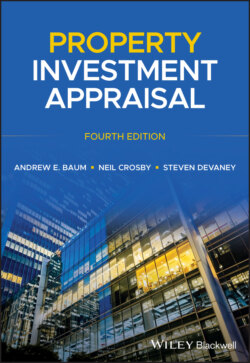Читать книгу Property Investment Appraisal - Andrew E. Baum - Страница 12
1.3 What Makes a Good Appraisal?
ОглавлениеThe property selection policies of both major and minor property investors often include an examination of the mismatch between estimates of Market Value and Investment Value to spot pricing anomalies. Given this, any investor or advisor will benefit from a clear understanding of the difference between the Market Value of an asset and its worth to an investor or group of investors. If there is a difference, is this evidence of a poor-quality market valuation?
It is widely believed that market valuations should primarily be accurate; that is, they should closely predict selling price. Therefore, accuracy may be a relevant and useful test of the quality of a market valuation. Investment valuations, on the other hand, should primarily be rational; they should be professional and expert reflections of a combination of objectively measured market variables and the prospective owner's subjective estimates. We will argue in this book that all appraisals, including market valuations, should be rational. If they are, then although accuracy can never be guaranteed, greater confidence will be generated in what will be perceived as professional and expert results. The three earlier editions of this book had the stated aim of encouraging better, more rational practice in the appraisal of property investments. We have little doubt that valuation practice has improved significantly in many ways. Appraisal methods have continued to be debated and, in the last 20–30 years, more research has been undertaken on the process of valuation, so that the context in which estimates of value are produced is better understood.
Given improvements in valuation techniques, we have been able to remove some of the older theoretical material regarding methods from this edition. Nonetheless, there are calls to improve valuation techniques further, especially in the context of lending, and these have been given momentum by the Global Financial Crisis. The use of Market Value as a reference point for lending has been identified as one of the pro-cyclical pressures leading to over-lending, which in turn feeds higher prices, enabling higher lending volumes based on static loan-to-value ratios. Therefore, alternatives are being sought, as discussed in Chapter 10.
The continuing globalisation of markets and the improvement of data sources has led to more attention regarding the convergence of international processes and practices. This has raised questions concerning different levels of lagging and smoothing of valuations in different countries. Such terms refer to the extent to which market valuations keep pace with changing prices and whether they capture the full extent of any movements in such prices. The performance of some valuation-based indices of national property prices raises questions about whether appraisers in some countries even noticed there was a global financial crisis at all! However, the increasingly sophisticated educational environment and continuing development of the property industry is increasing the ability of appraisers in practice to address the complexities of valuation, and the digitalisation driven by the fourth industrial revolution will push their capabilities even further.
International and national valuation standards have become more demanding in regulating communication between clients and appraisers. This communication involves the selection and appointment of an appraiser as well as the reporting of the valuation itself. There has been concern over the relationship between valuers and their clients, and academic research discussed below has suggested reasons why valuations might not be totally accurate and objective. The data now exists in some mature property markets to undertake long-term analyses of valuation accuracy and bias (measuring how close Market Value estimates were to subsequent sale prices). This includes variation between different valuers, the extent to which valuers anchor on past evidence and smooth peaks and troughs within cyclical markets, and whether valuers succumb to pressure from clients and other stakeholders in the process, and alter valuations as a result.
